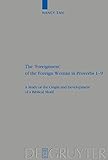The 'Foreignness' of the Foreign Woman in Proverbs 1-9 : A Study of the Origin and Development of a Biblical Motif / Nancy Nam Hoon Tan.
Material type: TextSeries: Beihefte zur Zeitschrift für die alttestamentliche Wissenschaft ; 381Publisher: Berlin ; Boston : De Gruyter, [2008]Copyright date: ©2008Description: 1 online resource (222 p.)Content type:
TextSeries: Beihefte zur Zeitschrift für die alttestamentliche Wissenschaft ; 381Publisher: Berlin ; Boston : De Gruyter, [2008]Copyright date: ©2008Description: 1 online resource (222 p.)Content type: - 9783110200638
- 9783110209839
- 223.706
- BS410
- online - DeGruyter
- Issued also in print.
| Item type | Current library | Call number | URL | Status | Notes | Barcode | |
|---|---|---|---|---|---|---|---|
 eBook
eBook
|
Biblioteca "Angelicum" Pont. Univ. S.Tommaso d'Aquino Nuvola online | online - DeGruyter (Browse shelf(Opens below)) | Online access | Not for loan (Accesso limitato) | Accesso per gli utenti autorizzati / Access for authorized users | (dgr)9783110209839 |
Frontmatter -- Table of Contents -- Acknowledgement -- Abbreviations -- Chapter One: Interpretations of the “Foreignness” of the Foreign Woman in Proverbs 1-9 -- Chapter Two: “Foreignness“ and the “Foreign Wives“ in Early Post Exilic Texts -- Chapter Three: The Motif of “Foreign Wives” in Deuteronomistic Literature -- Chapter Four: The Motif of the Foreign Woman in Proverbs 1-9 -- Chapter Five: Direct References to the Motif of the Foreign Woman in Other Wisdom Literature -- Chapter Six: The Motif of the Foreign Woman in the Apocryphal Wisdom Literature -- Conclusions and Implications -- Appendix: Other Foreign Women and Intermarriages in the OT -- Backmatter
restricted access online access with authorization star
http://purl.org/coar/access_right/c_16ec
This study is on the figure א-3;ה •4;•1;ה and -4;כ•1;׳ה, also commonly called the ‘Strange Woman’ in Proverbs 1-9. It is an attempt to understand the meaning which defines her, and the origin and development of her motif. The first part argues against defining her as a sexual predator, but as an ethnic foreigner according to the lexical studies of •4;•1; and -4;כ•1;. It traces her origin within the Hebrew scripture, the legal documents and especially to the DtrH's portrayal of foreign women/wives. Hence, it distinguishes the two motifs: the motif of the adulteress and the motif of the foreign woman; the latter, which symbolizes the temptation to apostasy. The study will then go on to explain how the writer of Proverbs 1-9 employs this motif of the foreign woman in his poetic composition. The second part tracks the development of this motif through the subsequent Jewish Wisdom literature and observes how it changes and loses the ‘foreignness’ of her original motif in Eccl. 7:26; 4Q184; LXX Proverbs; Hebrew Ben Sira; Greek Ben Sira; and finally disappears in Wisdom of Solomon. It proffers to understand this gradual transformation against a background of social and religious change.
Issued also in print.
Mode of access: Internet via World Wide Web.
In English.
Description based on online resource; title from PDF title page (publisher's Web site, viewed 28. Feb 2023)


